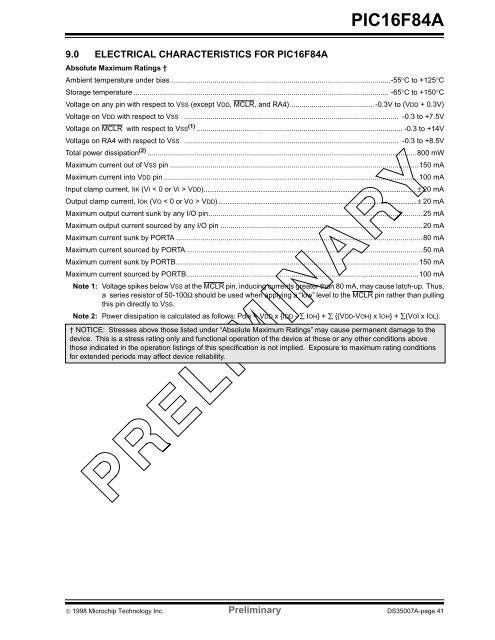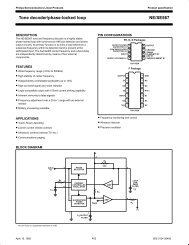PIC16F84A 18-pin Enhanced Flash/EEPROM 8-Bit MCU Data Sheet
PIC16F84A 18-pin Enhanced Flash/EEPROM 8-Bit MCU Data Sheet
PIC16F84A 18-pin Enhanced Flash/EEPROM 8-Bit MCU Data Sheet
Create successful ePaper yourself
Turn your PDF publications into a flip-book with our unique Google optimized e-Paper software.
<strong>PIC16F84A</strong>9.0 ELECTRICAL CHARACTERISTICS FOR <strong>PIC16F84A</strong>Absolute Maximum Ratings †Ambient temperature under bias.............................................................................................................-55°C to +125°CStorage temperature .............................................................................................................................. -65°C to +150°CVoltage on any <strong>pin</strong> with respect to VSS (except VDD, MCLR, and RA4).......................................... -0.3V to (VDD + 0.3V)Voltage on VDD with respect to VSS .......................................................................................................... -0.3 to +7.5VVoltage on MCLR with respect to VSS (1) ...................................................................................................... -0.3 to +14VVoltage on RA4 with respect to VSS .......................................................................................................... -0.3 to +8.5VTotal power dissipation (2) .....................................................................................................................................800 mWMaximum current out of VSS <strong>pin</strong> ...........................................................................................................................150 mAMaximum current into VDD <strong>pin</strong> ..............................................................................................................................100 mAInput clamp current, IIK (VI < 0 or VI > VDD).....................................................................................................................± 20 mAOutput clamp current, IOK (VO < 0 or VO > VDD) .............................................................................................................± 20 mAMaximum output current sunk by any I/O <strong>pin</strong>..........................................................................................................25 mAMaximum output current sourced by any I/O <strong>pin</strong> ....................................................................................................20 mAMaximum current sunk by PORTA ..........................................................................................................................80 mAMaximum current sourced by PORTA .....................................................................................................................50 mAMaximum current sunk by PORTB........................................................................................................................150 mAMaximum current sourced by PORTB...................................................................................................................100 mANote 1: Voltage spikes below VSS at the MCLR <strong>pin</strong>, inducing currents greater than 80 mA, may cause latch-up. Thus,a series resistor of 50-100Ω should be used when applying a “low” level to the MCLR <strong>pin</strong> rather than pullingthis <strong>pin</strong> directly to VSS.Note 2: Power dissipation is calculated as follows: Pdis = VDD x {IDD - ∑ IOH} + ∑ {(VDD-VOH) x IOH} + ∑(VOl x IOL).† NOTICE: Stresses above those listed under “Absolute Maximum Ratings” may cause permanent damage to thedevice. This is a stress rating only and functional operation of the device at those or any other conditions abovethose indicated in the operation listings of this specification is not implied. Exposure to maximum rating conditionsfor extended periods may affect device reliability.© 1998 Microchip Technology Inc. Preliminary DS35007A-page 41



